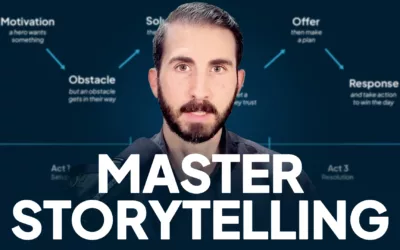Today, we’re talking about starting a marketing agency. How do you start and grow your own?
There are 10 steps, and to an extent, they’re applicable to businesses in any industry.
If you’re not starting a marketing agency, no worries. We still have tons of great advice.
If you’re growing a marketing department (you have a business already, but you’re just starting marketing), steps 1-6 all apply to you. These steps will teach you how to scale your marketing department specifically, not just a whole agency.
So, where do we start? Many people believe it’s easy. But the reality is that most new agencies today are failing. They just aren’t very good at what they do.
So, here are 10 steps for starting a marketing agency that will get you ahead of the curve. These steps can save you years of work as you start and grow your marketing agency from scratch.
1) Determine Your Why
Every entrepreneur needs to consider why they’re starting a company. If you’re just here for the money, you won’t last very long.
Some people want to grow a business and sell it. That’s fine, but it isn’t what we’re addressing today.
Knowing why you do what you do is a much better motivator than money.
Look at Tim Cook’s recent comments on Steve Jobs. He said Steve was never really interested in financial gains. His priority was to deliver a great product to his customers.
Filmmakers say something similar. Look at Tom Cruise and the most recent Top Gun title. According to Cruise, his primary motivator was the desire to deliver an entertaining movie to his audience.
If you have a different motivator, it doesn’t mean you can’t be successful. But deep motivation tends to get entrepreneurs further than pure financial motivation.
2) Consider Your Role
We know a lot of entrepreneurs. At ClearBrand, we’ve hired a lot of entrepreneurs. What we’ve found is that they often start their own companies because they think they can do a better job than their boss.
They leave their company, and start their own.
But what they don’t consider is that running a company is far more than just providing a product or service.
If you’re starting a marketing agency because you want to build websites, you shouldn’t be starting a marketing agency. You should instead work at one where you can build websites. When you start a company, you take on multiple roles. A small portion of your time knight be providing your product or service. But most will be spent doing other things.
Consider your role. What do you want to do? If you want to lead a team, start a marketing company. If you’re just there to do a job, work for someone else.

3) Choose What Your Company Will Do
There should be overlap between what you want to do and what your company is going to do. They don’t have to align perfectly. You don’t have to be the best web developer in the world to start a marketing company (although you probably do need the best web developers on your team). But, you will have to wear multiple hats. So make sure there’s some alignment between your interests and your company’s function.
With that in mind, let’s look at some options.
A lot of people look for a niche. It’s a good idea, but many people misunderstand what the word “niche” really means.
Here’s a common story about finding a niche: the story of Apple.
When Steve Jobs returned to the company in the 90s, the first thing he did was remove all of the extra products Apple had been launching over the past decade. Instead of putting energy into all of those other products, he wanted to focus intensely on one thing: the computer.
People hear this story, and think it means that you need to choose your niche – you need to choose who you’re going to sell to. If you’re a marketing company, it implies that you need to make a decision: will you sell to Fortune 500 companies? Will you focus on mom-and-pop shops?
This is how most approach considering what they’ll do. But they aren’t finding a niche. They’re really finding an audience.
There’s a difference here.
Imagine Steve Jobs had come back and said, “hey, we’re going to put all our efforts into computers. And we’re going to sell specifically to financial advisers earning between one and five million per year.”
Would it make sense? No! A strategy like this would prevent Apple from making sales to huge sectors of the market.
Do you see the problem here? When talking about finding niches, most people confuse them with finding an audience.
What you really need when starting a company is focus.
What do you want to do, and what does it take to deliver?
You can expand your focus with time, but starting with narrow concentration makes it easier to become fantastic at what you do.
4) Create A Team
Building a team is one of the easiest places to become stuck. We’re thinking, how can I hire employees if I don’t have revenue yet?
There’s a way you can build a team without having revenue: use contractors.
Find freelancers and negotiate a price. It can be hourly, or per project. Ideally, you can use the revenue you do have to pay your contractors, build your website, and expand your services. Then you can charge more.
Look for team members with solid portfolios and experience who will be available to work when you need them. Once you’ve assembled your team, you know you can deliver.
This is a starting point. With time, you’ll generate more revenue. With more revenue, you can start transitioning your contractors to full-time employees. But contractors are a great starting point, because give you the ability to establish consistent pricing and require payment per-project.
5) Create a distinctive brand
Branding is one of the best ways to build memories. And memories are the core of marketing.
This is an expense that will come up before you have revenue – you need to spend some money to start with clear branding.
That doesn’t mean you have to have a clear message ready to go. You can develop your message as you go along. But having a distinctive brand from day one will help people recognize your brand.
Recognition is what gets you more sales.
This is part of why a clear message is less important than clear branding when starting a marketing agency.
Over time, refining your message will allow your brand to better connect with customers, creating stronger memories and impressions. But in order to stick, customers need to associate them with a consistent image.
Paying a designer for a brand guide and a logo is the best way to create a distinctive identity from the start.

6) Prepare To Reach Out To People
This step is about outreach. It’s about knowing where to go to find your customers.
Ask yourself: where are people going when they want what I offer?
The answer might be social media like Facebook, Twitter, or LinkedIn. Wherever it is, that’s where you’ll go to find people who want to buy from you.
Think in terms of keeping yourself “in stock” at the places your customers spend the most time.
This is why we define an audience. Doing so helps us figure out where our customers are looking for products and services.
Start by choosing a single target audience. As you grow, you’ll have more time and money to expand who you’re targeting. For now, starting with a narrow scope makes it easier to identify exactly where you can find the most potential customers.
7) Deliver As Promised
This is why we built our team early. It’s time to deliver results, and we’re ready to do a great job. But what does that mean? When people nowadays talk about doing a great job, they often do so in terms of customer loyalty. They think that if they can build loyalty, they can retain customers and increase revenue.
According to the data, the truth is this: loyalty doesn’t exist.
When people talk about loyalty, they’re often pretending like they don’t have competition. But the truth is, you do. A lot of your competitors might be bigger than you, and they might be doing a great job.
So if you’re doing a great job too, you might be able to keep up. It doesn’t necessarily mean you’re outcompeting them.
If we imagine our competitors don’t know what they’re doing, it leads to arrogance, which negatively affects our own results. But if we imagine that our competitors are all great at what they do, it motivates us to do even better. Preparing to deliver results
8) Interview Clients And Build Out Your Message
As you make more sales, pay attention to the reasons people are coming to your company. What are your key entry points?
To find out, ask your clients directly. Record their answers, and look for patterns.
Intentionally interview your clients. Ask them about the exact moment they decided they needed to pay for marketing. But be careful here. Don’t make the mistake of asking why they chose to work with your company. This doesn’t provide information that helps you grow your company.
In the life of your customer, the decision to enter the industry is massive. There’s a motivator that causes them to take action. Focusing on why they entered the industry provides more actionable information than focusing on why they choose to work with you.
Interview as many clients as possible to identify broader patterns in their reasoning. If you can find out why they need marketing assistance, you can use use the answers to hone in and clarify your company’s message.
9) Start Inbound Marketing
There’s a difference between outbound marketing and inbound marketing. We covered outbound marketing earlier in Step 6. It’s when you go to the customer and offer your product or service on the platforms where they spend time.
Inbound marketing is the opposite. It’s when you help your customers find your company.
Use category entry points to attract people seeking your products and services. Again, we want to focus on why people are entering the industry. With this information, we can craft specific messaging that helps qualified leads find our company.
The most successful companies plan their advertising around category entry points. Doing so makes it easier to passively acquire new leads.
Knowing your category entry points also makes it easier to find suitable keywords for your content using a tool like Google Ads Keyword Planner. Checking volume and competition for individual keywords makes it easier to create content that attracts the leads you’re looking for.
As you identify more and more category entry points, you can expand your audience and target general consumers.
10) Start Scaling
At this point, you should be getting clients regularly. Maybe you’re considering quitting your job, or maybe you already have.
It’s time to grow, but you have to maintain a high standard of quality.
But as you grow, things get messy – more team members make it harder to communicate effectively, more projects makes it harder to keep track of progress, and more.
You can avoid the headaches that come with scaling by standardizing your operating procedures and using established systems. This way, you can accomplish more high-quality work with less time and manpower.
Use templates to write blog posts, ad copy, and any other content you need.
Create specific checklists that outline every step for completing each project.
Have a standardized onboarding process to make hiring new employees a breeze.
As you expand, having standardized systems in place for everything your company does makes it easier to onboard new employees, take on new clients, and monitor current projects.

Scale Fast With ClearBrand
Step 10 is where most companies miss the mark. Creating systems that work takes a long time and lots of trial and error. Luckily, ClearBrand offers a program containing everything you need to build and scale an effective marketing agency.
We offer access to our templates, our standard operating procedures, and every other system we’ve developed to make marketing a breeze. You also get access to the training and videos we use to onboard members of our own team. We address tons of questions that are useful for everyone, regardless of your company’s size.
It’s called ClearBrand Agency Accelerator, and we created it specifically to help you develop an effective marketing team. It can save you the hundreds of hours needed to develop your own frameworks from scratch. Think of it like a marketing agency in a box. To learn more about everything we have to offer, click the button below.







